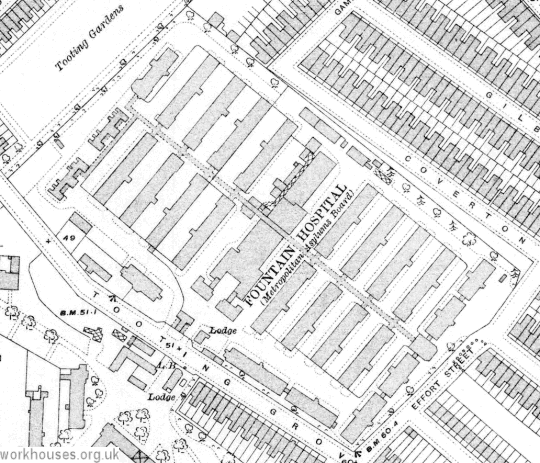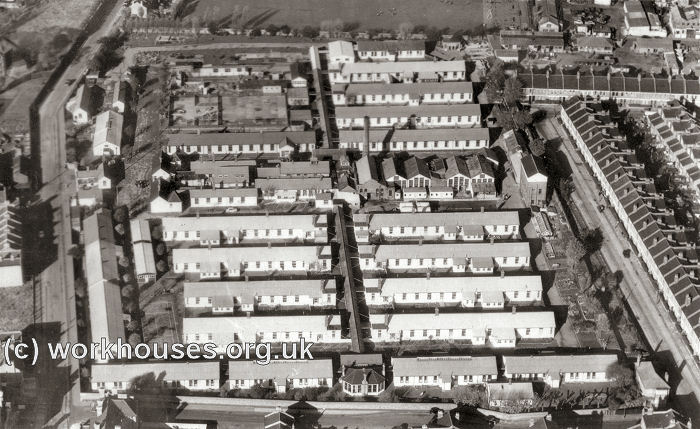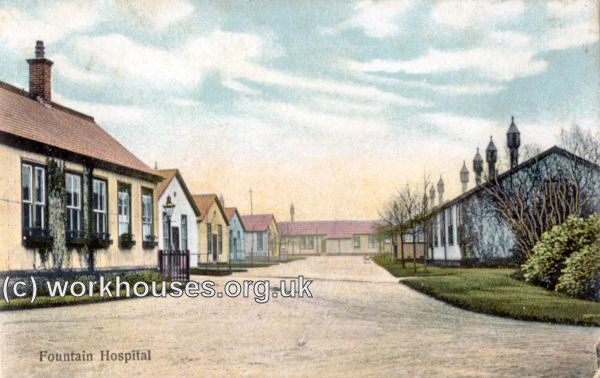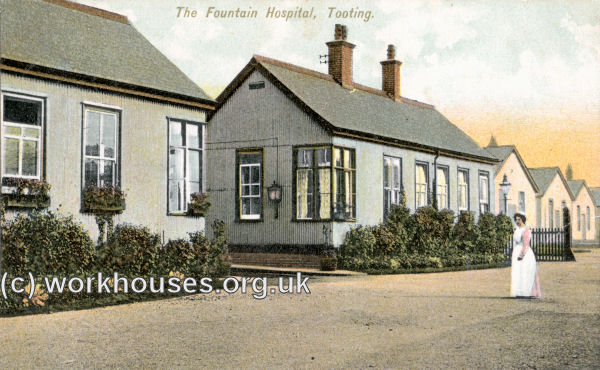The Fountain Hospital, Tooting
Tooting was the location for one of the new phase of hospitals erected by the Metropolitan Asylums Board in the 1890s. The MAB had been set up in 1867 to administer care for certain categories of the sick poor in metropolitan London. In 1891, its responsibilities were expanded to include the provision of fever and infectious diseases hospitals for all the capital's inhabitants. The following year, a violent outbreak of scarlet fever swamped the MAB's hospitals and a new temporary hospital, the North-Eastern at Tottenham, was opened in October, 1892. With a resurgence of scarlet fever in 1893, still more accommodation was needed. To provide this, the ten-acre site at Tooting was purchased for £4,395. The new 400-bed hospital, the Fountain, designed by Thomas W Aldwinckle, was erected and fitted out in nine weeks.
Most of the buildings were single-storey structures with timber frames standing on dwarf brick walls to floor level. Externally, they were covered with boarding, felt and corrugated iron. On the inside, the walls were lined with boarding and asbestos on plaster.

Fountain Hospital under construction, 1893.
© Peter Higginbotham
The map below shows the layout of the site in 1912.

Fountain Hospital site, c.1912.

Fountain Hospital from the south-east, 1920s.
© Peter Higginbotham
A porter's lodge stood at the west of the site at the entrance on Tooting Grove. It contained a gate office, waiting room, and lavatory, with discharging rooms and bathrooms to the rear. There were separate entrances at each side — the 'infected' one leading to the receiving wards, and the 'non-infected' one leading to the administration buildings and stores.
At the centre of the site, running south-west to north-east, stood the administrative building, with a boiler house and laundry to its rear.
To each side lay eight ward blocks, arranged in two rows of four, and all linked by a central covered way. Each block contained 24 beds, plus a scullery, attendant's bedroom and staff WC, linen room, and patients' bathroom. Two further isolation blocks were situated at the north-west edge of the site. The 'temporary' ward blocks were still in use in 1930.

Fountain Hospital, looking south-east from behind the entrance lodge, c.1913.
© Peter Higginbotham

Fountain Hospital ward blocks, c.1913.
© Peter Higginbotham
Accommodation for the different classes of nursing staff was provided in four blocks at the south-east of the site, with an attached recreation room. Further huts along the south-western perimeter housed the female domestic staff, and there was another at the north side of the lodge for the male servants. Workshops and a mortuary lay at the western corner.
In 1911, the hospital was redesignated as a mental hospital and became used for the accommodation of the lowest grade of severely subnormal children.

Fountain Hospital children's ward, c.1925.
© Peter Higginbotham

Fountain Hospital airing court, c.1925.
© Peter Higginbotham

Fountain Hospital airing court, c.1925.
© Peter Higginbotham

Fountain Hospital school room, c.1927.
© Peter Higginbotham
In 1930, administration of the hospital passed to the London County Council who retained it as a hospital for mentally defective children.
The Fountain was demolished in the 1960s and the site is now occupied by the St George's Hospital.
Records
- London Metropolitan Archives, 40 Northampton Road, London EC1R OHB. Has virtually all the surviving records for the Metropolitan Asylums Board and its instititutions. Search their catalogue at https://search.lma.gov.uk/.
Bibliography
- Ayers, Gwendoline, M. (1971) England's First State Hospitals and the Metropolitan Asylums Board (Wellcome Institute of the History of Medicine, London).
- Powell, Sir Allan (1930) The Metropolitan Asylums Board and its Work, 1867-1930. (MAB, London)
Links
- None.
Unless otherwise indicated, this page () is copyright Peter Higginbotham. Contents may not be reproduced without permission.


